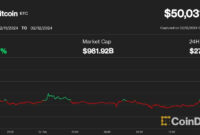CRYPTO MARKETS ARE MANIPULATED, WHAT WAS YOUR POINT? – cryptokinews.com
The nut of it is simple: Archegos borrowed a lot of money and used it to buy very large amounts of roughly 10 different stocks. That buying itself helped push the stocks up, giving Archegos paper profits that it could use to borrow more money – which it then used to buy the same few stocks, pushing them up further. The leverage play produced incredible results for a time: Hwang reportedly launched Archegos with just $200 million in 2013, but by its peak, the fund’s paper value topped $30 billion, a 1,400% return in eight years.
But it was a tactic with a limited shelf life. Archegos over time accumulated utterly absurd positions in several major stocks. According to the U.S. Securities and Exchange Commission (SEC), Archegos came to own as much as 45% of the outstanding shares in Tencent and over 50% of ViacomCBS (now Paramount Global) shares. One of the pillars of the fraud case against Hwang is that he lied to banks about these levels when borrowing money. And the way things played out shows why banks don’t often or willingly lend into this sort of concentration.
ViacomCBS was the pin that popped the Archegos bubble. The stock ran from about $35 in January of 2021 to nearly $95 by March. I’m speculating, but it seems very plausible that Archegos’ own aggressive buying (read: alleged market manipulation) contributed to the insane runup that motivated the sale of new stock. Either way, nearly tripling your money is good!
Except when it’s not. The runup motivated ViacomCBS execs to issue new shares, which in turn deflated the stock, which dropped 30% in three days. With its high levels of concentration and leverage, that 30% drop in a single stock wound up being enough to earn Archegos the world’s worst margin call. With the paper value of its holdings dropping against its outstanding loan obligations, Archegos was forced to liquidate – ultimately nuking the entire fund.
A Market Manipulator’s Paradise
Given the lack of oversight of cryptocurrency exchanges that matter — those with the highest trading volume — many of the behaviors that have since been outlawed by the financial markets are de rigueur in the Wild West that are the cryptocurrency markets.
From spoofing to frontrunning, insider trading to wash trading — every conceivable means by which markets can be made less fair can and often is, expressed in the cryptocurrency markets.
It’s What’s on the Inside that Matters
Take insider trading for example, which is probably the lowest hanging fruit when it comes to cryptocurrency market manipulation.
Because public blockchain data can be accessed by anyone, it’s not difficult to see insiders taking advantage to make some easy money.
Over several days last August, a cryptocurrency wallet amassed around US$360,000 worth of Gnosis tokens just days before Binance, the world’s largest cryptocurrency exchange by traded volume said that it would be listing Gnosis.
Expectedly the price of Gnosis soared, from around US$300 to US$410 in under an hour while at the same time, the trading volume for the token shot up to over seven times its typical weekly average.
Within four minutes after the listing of Gnosis on Binance, the wallet that had held on to US$360,000 worth of the token started dumping its stake over the next four hours, netting around US$500,000 or a profit of around US$140,000.
Using blockchain analytics software, that same cryptocurrency wallet has consistently demonstrated an uncanny knack for predicting which tokens would list on major exchanges such as Binance, and knew exactly when to accumulate and sell as well.
Coincidence?
Perhaps hubris, because whoever controlled those wallets didn’t even bother to cover their tracks knowing that there would be no consequences.
While blockchain analysis can determine that a particular cryptocurrency wallet address was prescient in knowing which tokens to hold on to and when to let them go, what can’t be determined is who actually owns it.
Although the biggest cryptocurrency exchanges all claim to have policies in place that prohibit employees from trading on privileged information, policing these measures is far more difficult.
And because blockchain transactions are anonymous, and many tokens can be traded on decentralized exchanges which require no KYC (know-your-customer) to trade on, it’s challenging to tie a trade to an individual and almost impossible when they obfuscate their cryptocurrency flows.
But insider trading, as unfair as they make cryptocurrency markets, are hardly the most reprehensible behavior in the industry.
Awash with Trades
In the early days of the cryptocurrency industry, when there was at one point more exchanges than there were tokens to list, many exchanges took to using so-called “market making” bots to create the illusion of active traded volume.
“Market making” in that sense was really just wash trading, where various accounts on an exchange traded with each other, representing a far more liquid and active market than otherwise existed in order to lure real human traders in.
These wash trading bots could even manipulate price charts, order books and create a parallel universe that an active market existed for a token, which was simply a work of fiction.
Such actions would be challenging to execute in the financial markets, but not impossible.
In October 2013, over US$6.2 billion in market cap was wiped out on the Singapore stock exchange as a Malaysian financier and his girlfirend manipulated the share prices of Blumont Group, Asiasons Capital and LionGold using a complex string of wash trades between trading accounts that they ultimately controlled.
Running out Front
Because an exchange can see a trader’s order, they can provide this information to their market maker (typically owned by the exchange as well) and put themselves ahead of that order so that a trader will always pay slightly more to buy a token and sell for slightly less before the price goes back to normal, whenever a market order is made.
The amounts made on frontrunning are typically tiny, may be a couple of basis points per trade, but over time and given the volumes, they can rapidly add up.
Cryptocurrency markets are hardly alone when it comes to front running.
In 2016, global banking giant HSCB made headlines when some of its staff front run a currency transaction for the bank to profit.
HSBC had been hired to convert dollars into British pounds for a company as it was preparing to complete the sale of a subsidiary.
Armed with the knowledge that a substantial amount of pounds would be in demand, two HSBC executives dealt head of the US$3.5 billion currency transaction, “ramping” up the price of one currency to benefit the bank at the expense of the client.
Spoof and It’s Gone
Spoofing is where a whole bunch of orders are placed to create the false impression of buy or sell pressure, only for them to be canceled at the last minute, luring in traders and leaving them holding the bag.
Also known as “layering” the order book, spoofing involves placing multiple, non-genuine orders on one side of the order book to manipulate perceptions of the trading environment.
For instance, by stacking up the ask, it looks like there are a lot more sellers than there actually are, and that may cause some traders to give up and sell out, whereupon the market manipulators then remove all of the sell orders and pump up the price of the token.
Between January 2008 and May 2014, NatWest, a London-based global banking and financial services firm, spoofed U.S. Treasury futures and spot markets.
According to prosecutors, NatWest injected materially false and misleading information about the genuine supply and demand for Treasuries into the markets, tricking other market participants into reacting to apparent changes in supply and demand.
Derivative This
Then there’s the issue of derivatives.
These days, many cryptocurrency exchanges offer a wide range of derivatives, some of which have no equivalent in the financial markets, such as perpetual futures that have no expiry.
But more importantly, exchanges also offer ridiculous amounts of leverage that would otherwise not be available in the financial markets.
You could get rich using 10x leverage, but you could get a yacht with 100x!
And that’s precisely what a lot of traders did and continue to do.
During periods of high volatility in the cryptocurrency markets (practically all the time), traders (gamblers) who fear missing out (buy) or are trying to get out (sell) place what’s known as “market orders “— whatever price the market will give.
As traders pile on positions heavily on one side, cryptocurrency exchanges through their market makers can take the opposite side of the trade and walk the price of the underlying token to wherever they need it to go (wash trading), liquidating these open futures contracts which post the bare minimum to keep those positions open — free money.
If futures are piled too heavily on the long side, exchanges can simply get their market makers to walk the price down and liquidate these open positions.
And if traders are almost uniformly bearish and take leverage to goose short futures bets, the exchanges will simply walk up the price enough to liquidate all of the positions and cash out.
While the amount of short futures and long futures is known, what’s not known by traders generally is the liquidation margins that everyone is maintaining — only the exchange knows that.
So the exchange also knows how much of a price move is needed to ripple through a whole stack of liquidations and typically, it’s not a lot, because most traders post minimum margin to hold the position open.
As a result, forced liquidations keep occurring, and traders keep losing their money — because exchanges have desks that actively trade against their own customers are able to front run, spoof and walk the price to whatever is necessary to take money from traders.
Finally, no discussion of market manipulation would be quite complete without the evergreen pump and dump.
The Classic P&D with a Side of Fries
Pumps and dumps primarily take two forms — insider-led or community-led.
There is no shortage of pump and dump Telegram groups, where anonymous individuals collaborate to bid up the price of a token to lure in other unsuspecting traders, similar to what happened with GameStop.
The other sort is where insiders corner the market for a particular token, wash trade to lure in other traders to come in while bidding up the price, and then dump all of the tokens acquired earlier on the unsuspecting bag holders as they come in.
Another way of course is for crypto celebrities to talk up a token which insiders have collected and dump it on unsuspecting investors who come in later.
And why is all of this possible?
Because cryptocurrency exchanges continue to be unregulated and even where they are regulated, this sort of behavior is exceedingly difficult to detect and even harder to prove.
To make matters worse, it’s not as though regulation can necessarily help matters anyway.
Even the highly regulated financial markets are not immune to manipulation and traders are regularly brought up on charges ranging from insider trading to rigging bids and offers.
As long as there’s a market, there’ll be someone out there who’ll attempt to manipulate it.
Nevertheless, it’s incumbent on investors, especially retail, to know what they’re getting into.
Take casinos for instance, it’s no big secret that the house has a mathematical advantage, but that edge is transparent and monitored by gaming authorities.
Gamblers who walk into a casino are aware that mathematically, the house will always have a leg up, but even though the odds are stacked against them, there are still opportunities for them to win as well.
To that end, cryptocurrency markets are no different.
So long as traders head to the centralized exchanges, they’re walking into a casino and the house controls every aspect of the experience.
From the order books to the trading volume, everything is engineered so that traders will take more leverage, trade more and over time, the house will always win, especially since the exchange charges a fee on every transaction.
What perhaps makes cryptocurrency markets that much more degenerate than casinos is because they’re not regulated, there’s no watchdog that is there to stop the most egregious forms of market manipulation being perpetrated on investors, especially retail.
And there’s no one who will speak on behalf of retail traders who are often the ones getting “rekt” by the exchanges or “whales” that ply the dark waters of the cryptocurrency markets.
Yet How is that Any Different from Wall Street?
In the run-up to the 2008 Financial Crisis, Wall Street stiffed Main Street by putting people in mortgages that were so complex even they didn’t understand them and which ultimately people couldn’t afford.
People got kicked out of their homes and had their properties liquidated by the banks, many committed suicide and others saw their entire wealth evaporate.
To add insult to injury, the American taxpayer had to fund a massive bailout of the very banks who were helping to perpetrate and if nothing else, encourage the very sort of activity that caused the financial meltdown to begin with.
At least in the cryptocurrency sector, if too many traders lose too much money too often, the exchange (casino) will eventually develop a bad reputation and players will take their chips elsewhere.
In reality though, as consolidation occurs in the cryptocurrency sector, this will become harder to do as a handful of major centralized exchanges soak up all of the global liquidity.
Which is where regulators must come in.
Unfortunately, given the decentralized nature of cryptocurrencies, it will be near impossible to stop exchanges setting up in light-touch jurisdictions, always staying one step ahead of regulators in the U.S. and Europe.
And traders will continue to be drawn to these offshore exchanges which provide them with the best trading experience, regardless of if they’re being traded against or not and even if the markets are manipulated.


